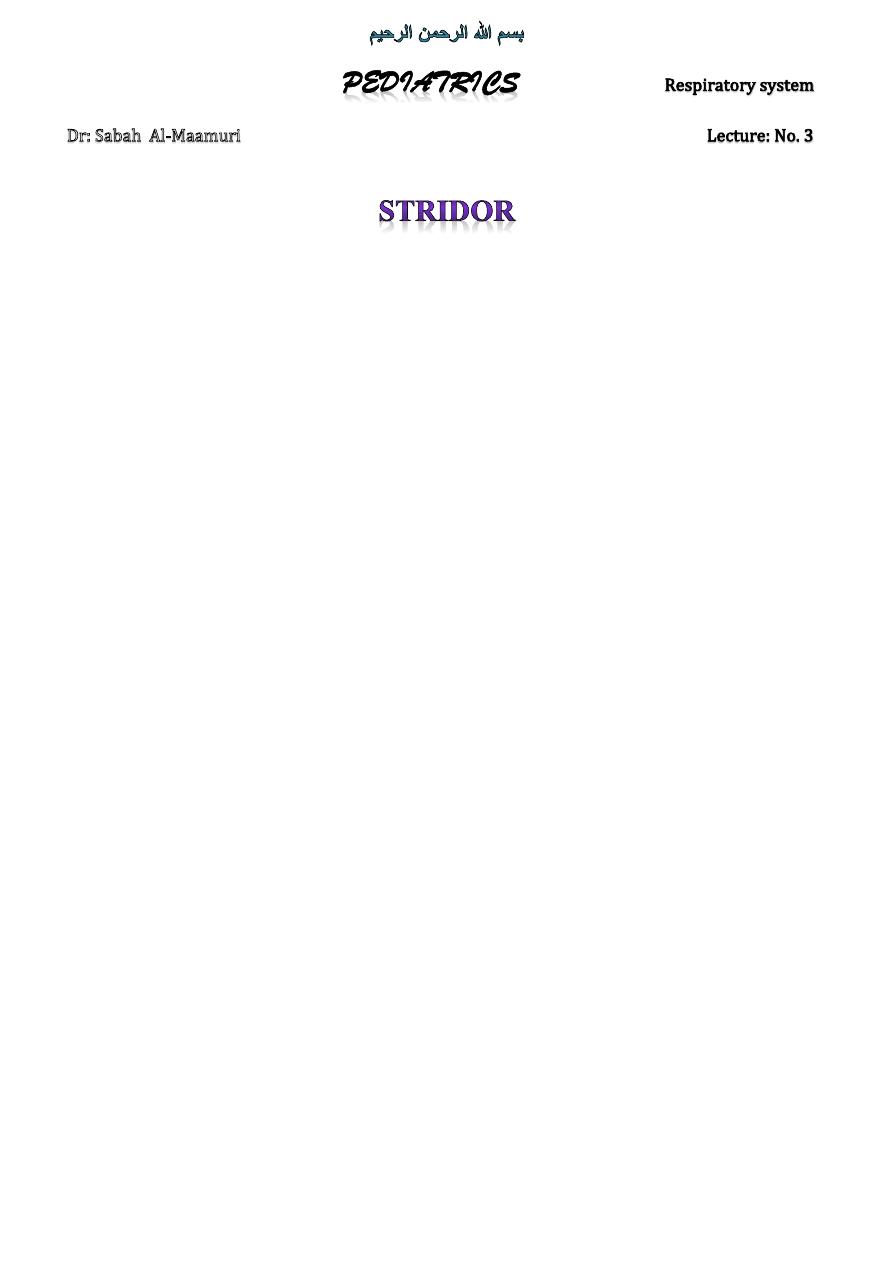
1
Stridor is a continuous inspiratory harsh sound produced by partial obstruction in the
region of the larynx or trachea. Total obstruction →cyanosis & death.
Etiology
Acute stridor
Infectious croup
1. Acute viral laryngitis
2. Spasmodic laryngitis
3. Laryngotracheobronchitis
4. Acute bacterial tracheitis
5. Acute bacteria epiglottitis
Other causes
1. Laryngeal diphtheria
2. Laryngeal foreign body
3. Laryngospasm
4. Laryngeal edema (allergy, post-extubation)
5. Laryngeal compression (acute)
Chronic stridor
Congenital chronic stridor
1. Laryngomalacia (most common)
2. Tracheomalacia
3. Laryngeal web
4. Laryngeal tumors or cyst
5. Laryngeal compression (congenital)
Acquired chronic stridor
1. Laryngeal stenosis
2. Tracheal stenosis
3. Laryngeal tumors
4. Laryngeal paralysis
5. Laryngeal compression (acquired)
Clinical grades of stridor
Grade 1 (Exertional stridor) : Stridor appears during crying or exercise.
Grade 2 (Continuous stridor or stridor at rest) : Stridor is present at rest & become worse with
exertion. Infants < 1 yr of age should be hospitalized.
Grade 3 (Stridor with retractions) : Stridor is continuous & accompanied with suprasternal&
supraclavicular retractions. The patient looks anxious, irritable, &struggling for breathing.
Hospitalization is indicated for all cases.
Grade 4 (Stridor with cyanosis) : In addition to continuous stridor & retractions, cyanosis& altered
consciousness occur denoting severe respiratory failure. Urgenthospitalization & ET intubation are
indicated.
Acute stridor
The onset is abrupt or acute & the duration of the illness is short (<1 wk). It is much

2
more common & life- threatening than chronic type. Most cases of acute stridor are caused by
common viral or bacterial infections of the larynx or the trachea (infectious croup). However, other
causes should be in mind & should be routinely excluded.
Infectious croup
It includes 5 clinical entities with increasing severity (3 viral & 2 bacterial). Viral
infections are more common & are usually milder than bacterial infections. Parainfluenza
viruses are the principal agents but other viruses may be responsible as influenza viruses,
adenoviruses, & RSV. With bacterial infections, fever is high & airway obstruction is severe.
Staphylococcus aureus (acute tracheitis) & hemophilus influenza type b (acute epiglottitis) arethe 2
main causative bacteria.
1.
Acute viral laryngitis :
It is a common viral infection which occur mainly in
children aging 1-3 yrs. The illness starts with mild fever, rhinitis, & croupy cough.
Stridor appears 1-2 days later & it is usually mild to moderate. Symptoms usually
subsides over few or several days.
2.
Spasmodic laryngitis :
It is a viral or propably allergic laryngitis which is
characterized by an attack of croupy cough & stridor that occur principally at night.
Stridor is usually moderate in severity & only lasts for several hours. The attack
may be repeated at nights of the 2nd& 3rd days but it is usually milder. Recurrencemay occur.
3.
Laryngotracheobronchitis (croup) :
It is a common potentially serious viral
infection which mainly occurs in children < 3 yrs of age. The illness starts with
mild to moderate fever, rhinitis, barking cough, & hoarseness. Stridor appears 1-2
days later & it is usually moderate to severe inspiratory one. Symptoms are
characteristically worse at night & often recur with decreasing intensity for several
days & resolve completely within a week. Agitation & crying greatly aggravate theillness. Chest
examination reveals slightly ↑RR. There may be ↓air entry, prolonged expiration, & expiratory
rhonchi. Rarely, the URT obstruction progresses →↑RR, nasal flaring, suprasternal, infrasternal, &
intercostals retractions associated with continuous stridor. Croup is a clinical diagnosis & does not
require a radiograph of the neck which may show the typical subglottic narrowing (steeple sign).
Radiograph should be considered only after airway stabilization in children who have atypical
presentations & it may be helpful in distinguishing between sever laryngotracheobronchitis &
epiglottitis in which the lateral neck X- rays reveals the " thumb sign" due to swollen epiglottis.
4.
Acute bacterial tracheitis :
It is a serious bacterial infection mainly caused by staphylococcuc aureus & principally occurs
in
children < 3 yrs of age. The illness starts with high fever & gradually progressive stridor. Airway
obstruction becomes severe & the illness simulates epiglottitis but direct laryngoscopy reveals
normal epiglottis. Polymorphnuclear leukocytosis is usually present.
5.
Acute bacterial epiglottitis :
It is a very serious & life-threatening infection mainly caused by hemophilus influenza type b
bacteria.
It has become a rare disease due to immunization. It principally occurs in children > 3 yrs of age (3-
7 yrs). The illness starts abruptly with high fever & rapidly progressive stridor. Airway obstruction
becomes severe within hours. Cyanosis & death rapidly occurs if urgent ET intubation is delayed.
Other signs are drooling of mouth ( due to inability to swallow) & laboured breathing. The child is
leaning forward with open mouth. The
barking cough is rare. Treatment consists of ET-intubation for 2-3 days or tracheostomy followed
by IV antibiotics.
Management
Home management
1. Most afebrile patients with mild infectious laryngitis, mild laryngotracheobronchitis, or
spasmodic laryngitis can be managed at home.

3
2. Worm & moist environment : by taking the child into a bathroom & turning on the hot shower or
hot taps. Inhalation of the hot steam will usually relieve minor obstruction within 30-60 minutes.
3. Drug therapy: Antibiotics (as amoxicillin) & steroids ( as dexmethasone) may be used especially
in borderline moderate cases to ↓need for hospitalization. Expectorants or mucolytics may be used
in croup.
Hospital management
1. Hospitalization
Is indicated in the following condition:
1. Any infant with grade 2stridor
2. Any child with grade 3 stridor
3. Suspected bacterial disease (high fever& severe obstruction)
4. Grade 4 stridor is an indication of immediate hospitalization & ET- intubation.
2.Close observation :
Frequent monitoring of HR, RR, degree of retractions, colour, &level of consciousness is very
essential to assess the course of the illness & to identify those in need for ET-intubation.
3.Minimal disturbances :
Nursing & medical procedures which disturb the child or ↑anxiety should be minimized. The
mother should remain beside the child for reassurance, at least until he sleeps.
4.Humidification :
Warm & moist atmosphere is generally useful. Inhalation of warm water vapor may be helpful in
relieving the laryngeal obstruction. This cool mist can be given by nebulizer (cold steam nebulizer).
The proposed mechanisms of this cool mist are that it : 1. moistens airways secretions to facilitate
clearance 2. Soothes inflamed mucosa & 3. provides comfort & reassurance to the child, & ↓anxiety.
5.Drug therapy :
It may include :
1. Nebulized epinephrine :
This →marked ↓in the need for tracheostomy in croup. The mechanism of action may be the
constriction
of the precapillary arterioles through the β- adrenergic receptors →fluid resorption from the
interstitial space
& a ↓in the laryngeal mucousa edema. It is indicated in : 1. moderate-severe stridor at rest 2. the
need for intubation 3.respiratory distress 4. hypoxia
5. when stridor does not respond to cool mist. It should be used catiously in patients with
tachycardia, heart conditions as TOF, & ventricular outlet obstruction because of the possible side
effects.
2. Corticosteroids :
It is the most commonly used & the most essential therapy in croup. This →↓edema in the
laryngeal
Mucosa through their anti-inflammatory action. A single IM dose of dexamethasone o.6 mg/kg
(sometimes, a dose as low as 0.15 mg/kg may be effective). Oral dexamethasone is also effective.
Oral prednisolone
1-2mg/kg may be used.
3. Antibiotics:
They are not indicated in croup (viral) but parenteral antibiotic therapy is important when a
bacterial infection is suspected especially in those with high fever. The choices are : Ceftriaxone 50
mg/kg/day single dose (or 100 mg/kg/day in 2 divided doses) or a combination of
Ampicillin+Sulbactam.
4. Sedatives are contraindicated because they impair consciousness.
5. Preliminary studies with Helium-O2 mixture (Heliox) have shown similar clinical
improvement in children with croup.
O2 therapy :
Although it is important to relieve hypoxia, this has 2 disadvantages : 1st,it delays the appearance
ofcyanosis which is an important indication for mechanicalventilation, 2nd, it is usually rejected by
the child & makes him more upset. However,O2 can be used if the patient tolerates it & if the
observation is to close.

4
Feeding :
Maintenance IV fluid is usually needed during the 1st24 hrs. Careful oralintake is usually initiated
from the 2ndday.
Mechanical relief of obstruction :
Fortunately, 98% of cases improve within 48 hrs with the previous measures. In 2% of cases, ET-
intubation (or tracheostomy) is necessary to relieve the severe obstruction. The main indications
are : cyanosis, altered consciousness extreme restlessness, or gradual progression of the degree of
the airway obstruction.
Patients may be safely discharged home after 2-3 hrs period of observation provided
there are no stridor at rest, normal air entry, normal color, normal level of consciousness, & given
steroids.
Prognosis
1.The outcome of acute laryngotracheobronchitis, laryngitis, & spasmodic laryngitis is excellent.
2.Most deaths from croup are caused by laryngeal obstruction or due to complications of
tracheostomy.
3.Untreated epiglottitis has a mortality rate of 6% in some series (bad prognosis), but of the
diagnosis is made & appropriate treatment is initiated at a proper time →better
prognosis.
